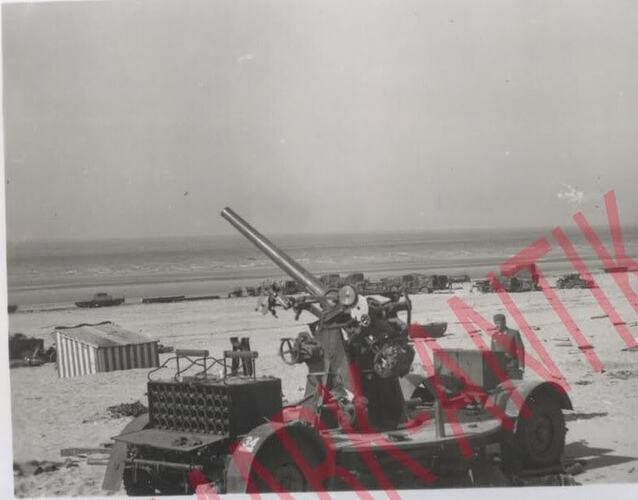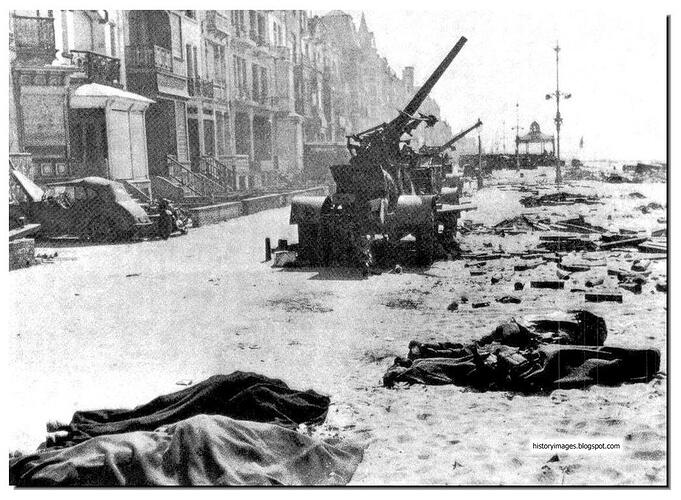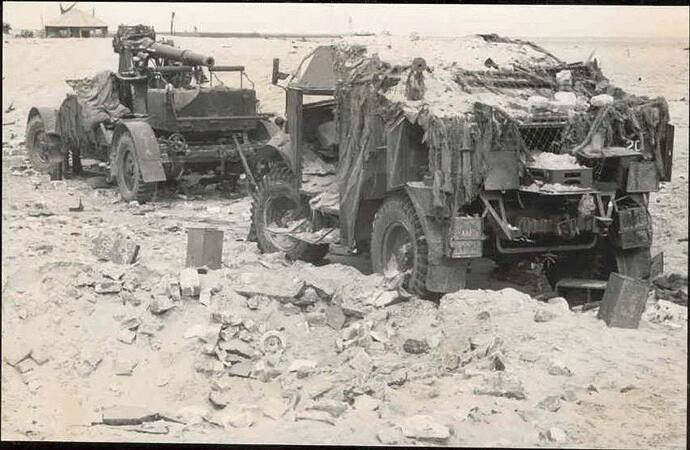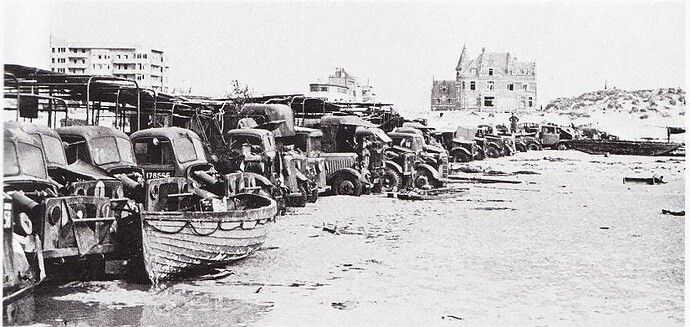I’ve read that Field Marshal Guderian halted his forces outside of Dunkirk because he was opposed to inflicting a bloodbath on the BEF. Also there was probably no practical way that he could make them all prisoners. Thoughts anyone?
I think this ranks with the fiction that Hitler stopped the German advance as he wanted to come to a peace with Britain and didn’t want to prejudice it by slaughtering the British.
My understanding is that the real reasons were that the German armour had outrun its supply lines and outrun German infantry; the country around Dunkirk wasn’t favourable to armour; and that the German commanders felt exposed to a possible counter-attack by the Allies and wanted to consolidate their forces and supplies before resuming the offensive.
Also, Guderian wasn’t the overall commander but subject to orders from above, so it wasn’t his call to stop the German advance.
I had heard that the Tanks were stopped for both supply reasons, and Maintenance / repairs, which were allegedly sorely needed. Although I have not read, or heard it to be true, It would not surprise me at all to learn that the German Commander stopped the advance in order to allow the remnant to be rescued as they were in no condition to fight, or defend, nor would they be so for some time after having to abandon all of the heavy equipments. So any additional ground attack would appear to the World at large to be murderous slaughter. This consideration would be more the choice of a Professional Officer of long experience rather than a born again, Blut Fahne fondling Party member, especially if the Germans had no facility, or resource for processing, and holding such a huge number of Prisoners.
The Germans had already panicked at Arras with Rommel declaring he wa being assaulted by several Allied tank Divisions - which caused a halt and German Panzers to be turned round to deal with this threat to their rear.
The Ground Forces did not really halt outside Dunkirk, the defenders were amply supplied for their needs, could not be outflanked, in terrain that favoured infantry rather than tanks. The tank forces were therefore halted to resupply and maint while the infantry caught up to assault what was rapidly becoming a heavily defended position.
One attempt by Germans to use tanks to break through what was perceived a weak position was halted by well sited British 3" AA guns in the AT role.
Lots can be said with most saying the Germans were wanting to prevent slaughter etc etc - but when did they ever show that restraint - bombing city’s and refugee columns, atrocities in France and Belgium against military and civilian prisoners. They still tried to bomb those poor helpless troops from the air - why do that and why try to sink the ships if you wanted them to get away - does not add up.
The only thing that does is the Germans could not take them by ground assault before the defences were solidified - once they were it was a very costly battle for them and the mainly French rear guard holding out.
I knew that the German 88mm was adaptable to AA or AT and very effective in the latter role, but didn’t realise that the British had a 75mm or thereabouts AA / AT gun. Was it in common use in WWII and, if so, how effective was it in the AT role?
Many people attribute the Germans to first using the Flak 88 as an AT gun and the whole idea of the heavy AA guns having a dual use.
Pre war (from the 1920’s) it was part of the Annual shoot for all heavy AA regts to do an AT shoot as part of their training. The 3" AA fired a 12 1/2 pound AP Shot from the case that was later used with improved propellant and a 17pdr projectile for the 77mm on the comet so imagine the effect in 1939/40.
This was stopped with the introduction of the 2pdr as a dedicated AT gun, the 3" AA was then to be used for its primary design as there was not enough to go round - the newer 3.7" was also not as well suited to the ground use with its carriage being designed for high angle use.
All AA units though still kept stocks of AT ammunition for local defence (in North Africa it was doctrine for all AA guns HAA 3", 3.7", LAA 40mm, to be positioned for AA and ground use if possible) and contrary to popular thought, the British did use their 3" AA in 1940 for ground use and their 3.7" in North Africa, Italy and Western Europe.
The 3" AA on field mount - much easier and quicker than the 3.7" to bring into action as it was fired from the wheeled mount and screw jacks were wound down either side.
Thanks for that.
I confess that I was under the impression that only the Germans had a useful dual purpose AA/AT weapon. I was also under what I think is a common misconception that the British weapons couldn’t depress enough to be used in AT roles. No doubt it also reflects my relative lack of interest in weapon details in preference for wider strategy and related issues.
The screw mounts rather than a spade, on what I assume was a wheeled mount set at right angles to the barrel in firing position, suggest that there wasn’t a lot of recoil. Was this so?
For high trajectory fire most force is directed downwards, so the screw jacks which can just be seen midway between the wheels on the image I posted give enough stability (the weapon was initially a WW1 design), I have not read what the horizontal recoil force would be like but I should imagine nothing like the M56 Scorpion which was deemed still good and accurate enough for service. The Cruciform system used on the Flak 88 and 3.7" gave much better stability to handle the much higher MV and forces of those guns.
The weapon had a full 360 degree traverse on this mount, which was one of many types over the years.
It does beggar belief that only 50 were converted to AT guns on two wheeled carriage, with another 50 mounted in Churchill hulls to become the 3" Gun Carrier as they were retired from AA use with all kept for home defence. They would have been very useful to supplement the 18 pdrs and 25 pdrs used as temporary AT guns in North Africa. But some British decisions in WW2 really defy logic when looking back with hindsight.
leccy,
Is the gun in your photo a captured one?
Looks like a German soldier to the right of it.
That was one of the ones used on the parade next to the beach at Dunkirk - three at least were in a row on the promenade defending the beach until ammunition ran out - it was odd that some of the ships taking away troops were also bringing ammunition in for the defenders.
One in traveling position on the beach
One of the little known but very important constructions to be defended - the improvised piers
Assuming that the defenders needed ammunition, that seems a sensible process to extend the defence and protect the evacuation.
Or was there already sufficient ammunition there?
Separate issue: The AT guns kept for home defence could, if suitably used (which is debatable in the rather chaotic retreat down Malaya) have made a useful difference against Japanese tanks in Malaya 18 months after Dunkirk, by which time there was little prospect of Germany invading Britain. Although that would not have altered the eventual result, so those guns would have been lost with everything else in Malaya / Singapore.
Certain types of ammunition especially 2 pdr AT and AA were in short supply (in actual unit hands) when the Germans launched their assault, supply dumps were lost or destroyed in the chaos of the retreats with HQ often having no contact with their sub units for long periods.
Ref AT guns the British made some decisions that looking back now were bad - but at the time, in the situation they were in - I can understand to an extent - I possibly would have gambled and got the 6pdr into production in 1940 when it should have been - in at least one factory.
Also, Guderian wasn’t the overall commander but subject to orders from above, so it wasn’t his call to stop the German advance.
That is why I believe Hitler halted German forces to allow the British to escape. Only Hitler was in charge of halting and moving german forces.
To a large extent that reflects the plenitude of materiel the British had in comparison to the Germans - they didn’t make much use of dual AA/AT guns because by and large they didn’t have to, having a sufficiency of dedicated designs of both for most of the war.
I suspect in North Africa it was probably a logistics issue - supplying an additional 25pdr shell type is much, much easier than keeping an entirely different weapon supplied in theatre complete with spare parts, ammunition, etc. It needs to be remembered exactly how hard it was to supply the North African theatre for the British at this point - I’ve seen estimates of over 100,000 men working on the logistics for the campaign, with everything needed having either to go around the Cape and then along the coast road from Suez or flown overland via Takoradi.
The 3" gun did remain in anti-tank use until 1973, however. What happened was that the 17pdr was too big for some tanks like the Comet so the 17pdr ammunition (which was 3" in diameter) was bodged together with the cartridge of the 3" 20cwt AA gun and the resulting weapon called the “77mm HV” and was used on the Comet.
Yes the good old 77mm - 3" Shell case with 17pdr projectile and propellant, in a modified 3"/17pdr/Vickers 75mm HV bodge gun - remained in British frontline service until the mid 1960’s in Hong kong and with other nations much later.
Built as the Cromwell chassis/turret ring could not take the force of the Vickers 75mm HV nor the 17pdr - proven a teeny bit of a lie as post war they fitted 20pdr and even the L7 105mm in a modified (admittedly thin armour and 2 man) turret on them to make the Charioteer.
I’ve got nothing in terms of info on this but I would like to think it true. On another note, I am really looking forward to Christopher Nolan’s “Dunkirk” due out next year. I just hope he can do it justice.
because Hitler was generous
I wouldn’t call the sinking of RMS Lancastria or the Wormhoudt massacre generous.
There is a theory that old Adolf halted the panzers in order to get a hold of his increasingly unruly generals and as a way to reestablish Nazi Party control over the military and so that the Battle would be seen as a Nazi victory rather than a purely German Wehrmacht one. Goering also lied to Hitler routinely and over estimateed and oversold his Luftwaffe’s ability to annihilate the garrisons at Dunkirk and to prevent a naval evacuation. In The Blitzkrieg Legend, Karl-Heinz Frieser states this coming largely from a German post-war military (hindsight) point of view. I myself don’t particularly agree and think there were many reasons the Germans halted already stated in this thread. Not least of which was the Battle of Arras that unnerved the German command quite a bit and the lingering fear that the Allies had something of a surprise up their sleeve are probably more plausible. Also, the Germans didn’t think the Allies would be able to evacuate because they had no similar capability so in an odd way it was difficult for the Germans envision things in purely naval terms as the Kriegsmarine was weak and they had little amphibious warfare experience and they often failed to accurately account for the British naval and shipping capabilities…
I heard that Hitler did not want to inflict a catastrophe on his British “cousins”, thought that they would eventually come to terms, and thus ordered the halt. Plus the blowhard Goering insisted that his Luftwaffe could do the job of finishing off the British. In the end such actions proved devastating - to the Germans themselves.




